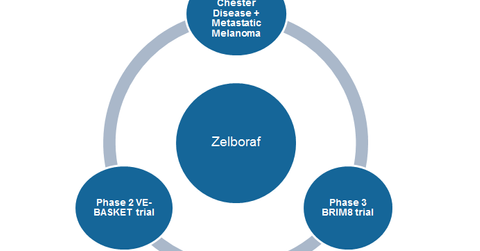Zelboraf Could Boost Roche’s Sales Growth in 2018
Roche’s (RHHBY) Zelboraf (vemurafenib) is indicated for the treatment of individuals with unresectable or metastatic melanoma with the BRAF V600 mutation.
Jan. 12 2018, Updated 7:32 a.m. ET

About Zelboraf
Roche’s (RHHBY) Zelboraf (vemurafenib) is indicated for the treatment of individuals with unresectable or metastatic melanoma with the BRAF V600 mutation.
Recent approval
In November 2017, the US Food and Drug Administration (or FDA) approved Roche’s Zelboraf for the treatment of individuals with Erdheim-Chester disease with the BRAF V600 mutation.
Erdheim-Chester disease (or ECD) is a rare disease characterized by an abnormal multiplication of certain WBCs (white blood cells) called histiocytes. A study estimated that there are less than 500 cases of ECD in the US, and that 50% of individuals with ECD have BRAF V600 mutation-positive disease.
FDA approval of Zelboraf is based on the results of the phase two VE-BASKET trial. The concluding results from the phase two VE-BASKET trial demonstrated a 54.5% overall response rate (or ORR).
Previously, in 2011, Zelboraf monotherapy received FDA approval for the treatment of individuals with metastatic melanoma with BRAF V600 mutation.
In September 2017, Roche presented the results from its phase three BRIM8 trial. Roche conducted the phase three BRIM8 trial to evaluate the safety and efficacy of Zelboraf as the adjuvant (after surgery) treatment of individuals with completely resected BRAF V600 mutation-positive melanoma.
Roche’s phase three BRIM8 trial was conducted in two cohorts: cohort 1 (stage IIC-IIIB) and cohort 2 (stage IIIC) melanoma patients. The phase three BRIM8 trial did not achieve its primary endpoint of significant reduction in the risk of recurrence or disease-free survival in patients with stage IIIC melanoma or cohort 2. However, in cohort 1, Zelboraf demonstrated 46% reduction in risk of recurrence.
Zelboraf’s peer in the metastatic melanoma with BRAF V600 mutation market is Novartis’s (NVS) Tafinlar+Mekinisk. In 3Q17, Tafinlar+Mekinist generated revenues of $224 million. Other notable metastatic melanoma drugs include Merck’s (MRK) Keytruda and Bristol-Myers Squibb’s (BMY) Yervoy. The growth in sales of Roche’s Zelboraf could boost the Vanguard FTSE Developed Markets ETF (VEA). Roche makes about ~2.1% of VEA’s total portfolio holding.
